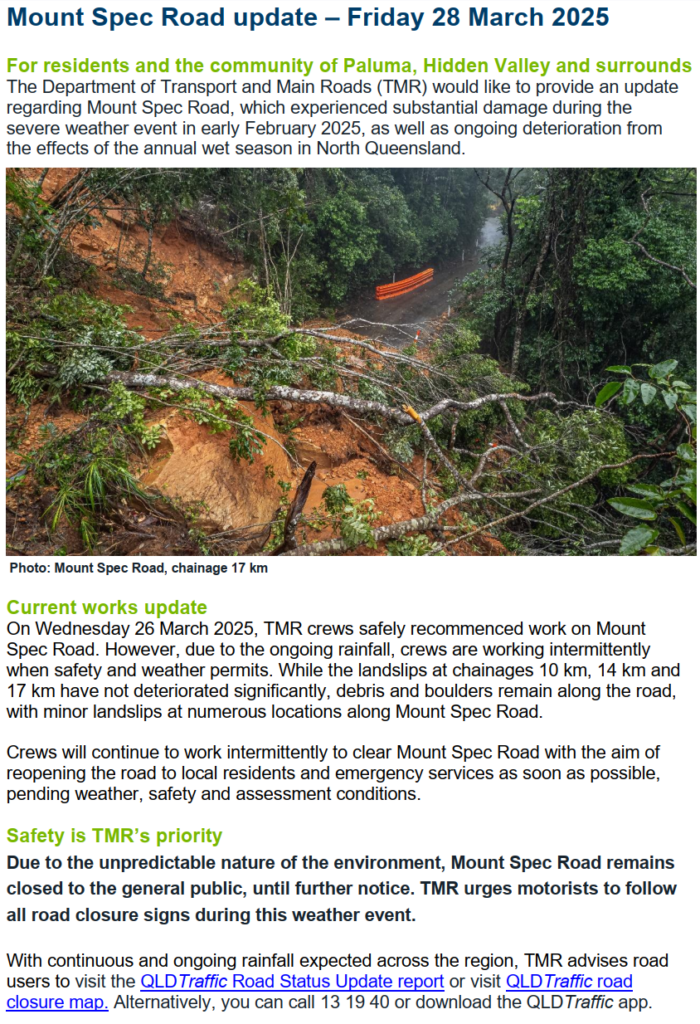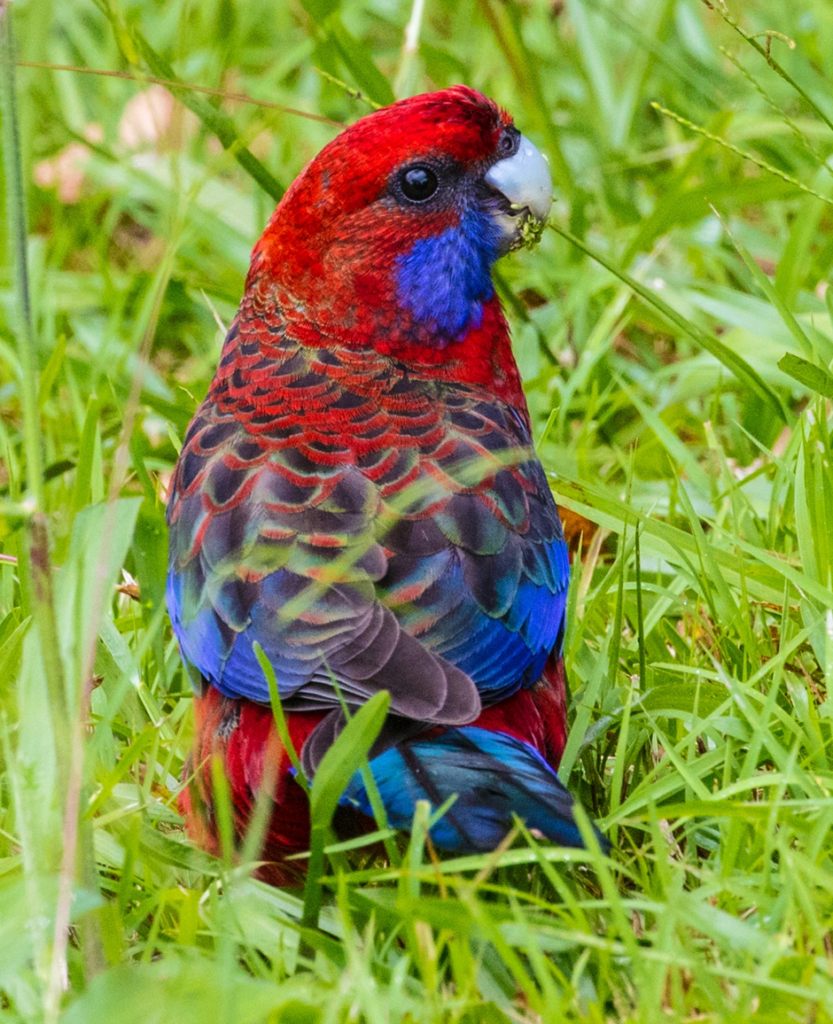
TMR Range Road Update 16







Prior to the meetings below the PDCA will provide a BBQ lunch at noon, April 12th at the Community Hall
A community meeting to review our experiences during & after the February extreme weather event will now be held on Saturday, 12th of April, commencing at 1 pm in the Paluma Community Hall. The objective is to record lessons learnt for the future, discuss known problems & see what we can do to improve how we manage such events. All members of the community are encouraged to attend. See agenda here.
If you are unable to attend but would like to have a specific issue included for discussion, feel free to contact Charlie Allen, Peter Cooke, Anneshka Brown or Jamie Oliver to let them know.
There will also be a regular meeting of the PDCA Council at 3pm, after the community meeting. This PDCA meeting will cover various ongoing items (see agenda below). While these meetings have traditionally been considered as business meetings attended only by the elected members of the Council/Executive, we welcome any residents to attend and to raise any items that they would like the PDCA to consider in addition to what is already on the agenda. Here is the proposed agenda.





Peter and Violet were heading down to Ingham yesterday when they came across a Boyd’s Forest Dragon (Lophosaurus boydii) in the middle of the road out near Graham Pope’s place.

The dragon wasn’t bothered by being the subject of an intense photo session, first by Peter and Violet, and after that by Jan and me when we got out there after a call from Peter and Violet.
It remained motionless even when we got down to take close-ups from only about 30cm away.
Adult male dragons are about 48cm and females around 42cm but this one was around 30-35cm and probably a juvenile.
L. boydii is restricted to rainforests and their margins in the wet tropics, from just north of Townsville to near Cooktown. It is found in both upland and lowland rainforest, and is often seen around Lake Eacham and Lake Barrine.
Unlike most other lizards, Boyd’s forest dragon does not bask in the sun, instead letting its body temperature fluctuate with air temperature thermoconforming rather than thermoregulating.
Boyd’s forest dragon spends the majority of its time perched on the trunks of trees, usually at around head height, although daily movements can exceed 100 m (330 ft) on the ground. After being motionless for maybe half an hour, it took a nudge with a stick to encourage it to get off the road. When it moved, it moved very fast, semi upright with front legs off the ground and back legs pedalling like crazy.
Thanks to Peter, Violet and Wikipedia.
Photos and text submitted by Peter Cooke
Early this week a curious reptile turned up at the “top border gate” blocking the range road. It parked up on the bitumen while many photos were taken.


Three ecologists/herpetologists were consulted and all agreed this is a healthy and happy specimen of Coeranoscincus frontalis — aka the limbless snake-toothed skink.
It currently sits within the Coeranoscincus genus but ecologist Nic Gambold believes it may be on the way to getting a genus of its own. Amongst the professionals taxonomy and peer review moves slowly but carefully.
Michelle Bird’s herpetologist mate Greg Calvert commented that it’s a rare day he ever sees one of these and the good news is that after being listed as a threatened species for many years it has now been reclassified as “least concern”.
Jamie Oliver found one here in 2023 and posted pictures and a story on Paluma.org.
C. frontalis is a Wet Tropic Species, but other members of the Coeranoscincus genus are found much further south.
C. frontalis at around 29cm (nose to vent) is the longest species in the genus. Our visitor was probably between 30-35cm overall, so quite a big one.
C. frontalis hangs out in the rainforest under logs and leaf litter and worms are a favorite food. I guess the reference to snake-toothed means it’s well equipped for this task.
Unlike a number of other legless lizards which have visible vestigial legs, C. frontalis has no sign of legs.
Eventually, the specimen at the range gate decided to move on but just couldn’t get any traction on the wet bitumen and needed a lift into the verge. It then quickly headed back to the privacy of the rainforest, but not before revealing the strong orange/yellow underbelly and other attractive markings.

Story and pics by Peter Cooke,
with thanks to Nic Gambold, Laurie Ross and Greg Calvert.


The Wet Tropics crimson rosella (Platycercus elegans nigrescens) is commonly seen at Paluma delicately feeding on lawn seeds or flowers like the Albizia outside the Ivy Cottage.

P. e. nigrescens is the smallest of sub-species of the widely distributed crimson rosella. The sub-species was first described in 1988 by Edward Pierson Ramsay who noted its darker crimson plumage, black back and nape, and smaller size yet larger bill. It was also known as “northern crimson parrot” or “Campbell’s parakeet”, after Alexander James Campbell.
Wet Tropics crimson rosella is an appropriate common name based on its limited distribution.
In the breeding season, Wet Tropics crimson rosellas will only forage with their mate. Outside of the breeding season, crimson rosellas tend to congregate in pairs or small groups and feeding parties. The largest groups are usually composed of juveniles, who gather in flocks of up to 20 individuals, usually much fewer at Paluma. When they forage, they are conspicuous and chatter quietly.
Mutual preening is not exhibited by the playcercus genus, and the courtship display is simple; the male waves his tail sideways, and engages in some head bobbing, and the female reciprocates.
The female chooses the nest site. Like most parrots, they are cavity nesters, generally nesting high and in deep cavities in older large trees in forested areas. They generally have a clutch size of several eggs which are incubated for around 21 days by the female alone. The male feeds the female through this time and for some time after incubation concludes. Quickly covered in white down, chicks take around five weeks to fledge.

Platycercus are most proprietorial of their nesting sites. During the breeding season, it is common for females to fly to other nests and destroy the eggs and in fact, this is the most common cause for an egg failing to hatch. This behaviour is thought to be a function of competition for suitable nesting hollows, since a nest will be abandoned if all the eggs in it are destroyed.
A pair of rosellas will tend to nest in the same area from year to year during their 20-year lifespan.
The name rosella is said to have come from the first encounters of Early European settlers with eastern rosellas at Rose Hill, New South Wales, now Parramatta, and so they called it the Rosehill parakeet, which became “Rosehiller”, and eventually “rosella”.
The species as it now stands has subsumed two former separate species, the yellow rosella and the Adelaide rosella. Molecular studies show P. e. nigrescens, one of the three red-coloured races, is genetically more distinct.
Compiled by Peter Cooke from a variety of sources, mostly Wikipedia.
Photos also by PC.